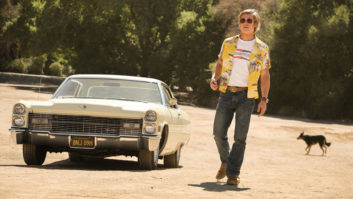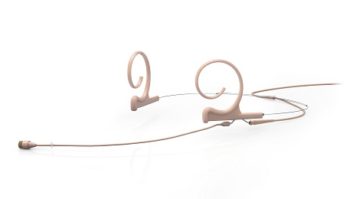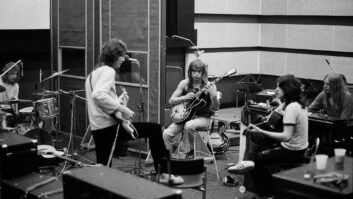Last month, I complained about the inability of the many digital radios in my house to receive my favorite public station. Before that, I took on the record companies. So the first half of this month’s “Insider” is about radio reception, and the second half is about CD copyright issues.
WUMB, from the University of Massachusetts Boston, broadcasts folk and acoustic music ’round-the-clock from a 660-watt tower on 91.9 MHz, a scant dozen miles away from my house. According to chief engineer Grady Moates, the answer to my dilemma lay in analog-tuner technology. But no one has seen an analog tuner in years, right? Slide-rule dials, tuning meters and big knobs went out in the ’80s when digital tuners took over. With a keypad or a remote control, like a TV tuner, a digital tuner will land you squarely onto the right channel the first time, every time. Unfortunately, that doesn’t mean that you will hear what’s on that channel, because in most urban areas, there’s so much off-channel garbage leaking into your set that it can overpower even moderately strong signals.
Enter the late Henry Kloss. In the June edition of “Insider Audio,” I wrote that Kloss had passed away, leaving us a legacy of consumer audio products that made huge contributions to increasing the size and sophistication of the music-listening public. His last company was, typically, a pipsqueak engineering lab with one initial product: a table radio. It’s called Tivoli Audio (and, yes, the Website is www.tivoliaudio.com).
Tivoli Audio was the brainchild of Kloss and Tom DeVesto, who first teamed up with Kloss way back when Advent was turning out then-revolutionary hi-fi cassette decks and loudspeakers. The two men started Cambridge Soundworks in 1987, making small, high-quality, three-way, “multimedia” speaker systems and other mini-components. You may know Tom DeVesto’s voice: It was on the radio quite often for the better part of a decade, declaiming “Hello from Cambridge Soundworks!” and always preceded by a truly obnoxious sine wave sweep.
“It got your attention, didn’t it?” he laughs today. “Those ads gave us an immediate identity, which is very important with radio. No one told us they wished the oscillator sound went on twice as long, but it worked.” His conversational voice is far more pleasant, and less insistent than in his commercials. The distinctive radio ads were first produced in their own factory, on a pair of Advent cassette decks and mics, with various types of test tones sounding in the background as technicians worked. When the ad production went pro, they kept the sound.
Cambridge Soundworks was bought in 1998 by Creative Technology, the giant Singapore company that brought us the infamous SoundBlaster card, and that also now owns E-mu and Ensoniq and makes Nomad MP3 players. DeVesto didn’t really want to sell the company, but “it was publicly traded and the offer went so high, my attorney tapped me on the shoulder and said, ‘If you don’t sell, the shareholders will get mad.’ So I left the company, and sat on a non-compete agreement for a while.” Not to mention a decent pile of cash, I’m sure.
But before the company started, when Advent went bankrupt in the early ’80s, he and Kloss bought the entire remaining stock of Advent table radios. (One of my first “business” reporting assignments for a magazine was to go to New Hampshire and cover the bankruptcy auction. It was a very depressing sight. The hottest items were a couple dozen IBM Selectric typewriters. I bought a box of unlabeled tweeters.) “Those radios were legendary,” he says. “Every time someone Henry or I knew had a wedding or a bar mitzvah, they got a radio. And in divorce proceedings, who got the radio was sometimes a big issue.”
So after the non-compete agreement ran out about two years ago, the two went back to where they once belonged, and introduced, yes, a table radio: The Tivoli Audio Model One, which sells in mid-level and high-end retail audio stores (but not at Cambridge Soundworks outlets) for about $100.
What’s so special about the Model One? It’s a simple, mono, tabletop AM/FM radio. It has an internal FM antenna and a jack for an external one. It sounds quite good for something its size. But, amazingly, this little sucker picks up and sorts out stations that none of the other tuners in my house can touch. In fact, it does such a good job of this that, in 2001, the readers of Stereophile magazine, that venerable journal of home audio tweakers, tinkerers and big spenders (their idea of a “budget” stereo system is anything that costs less than $5,000) voted it one of the 10 best “analog source” products of the year. The next least-expensive item on the list was a $2,000 phono cartridge. The other FM tuners on the list were…well, actually there weren’t any.
When I brought a Model One home, I set it up right next to the old Sony cassette boom box, which was the only radio I had that could pick up WUMB. The Model One is extremely unprepossessing: There’s an on/off AM/FM switch, a volume knob and the large tuning knob, a power lamp and a yellow tuning indicator. It has a 3-inch speaker in front, and a port running through the middle from the bottom up to give it some bass. No bells, whistles, displays or infrared remotes. I attached the little single-wire antenna that’s included and turned it on. A few counterclockwise tweaks of the dial, and there it was, crystal clear: my favorite radio station, WUMB.
How does the Model One do it? According to Tom DeVesto, it has to do with the fact that the manufacturers didn’t just drop a standard VLSI into the tuning section, but instead opted for discrete components based around Gallium Arsenide Metal Semiconductor Field Effect Transistor (GaAs MES-FET) technology, which he claims works better than ICs or bipolar transistors when it comes to sorting out multiple strong signals. The technology is used in cell phones, scanners and other UHF applications, but it had never been used in a commercial FM tuner. It makes it possible for the radio to reject spurious off-channel signals from strong stations, whether they are generated at the transmitter or within the receiver itself. So at my house, WUMB isn’t getting knocked around by the much more powerful FM and TV transmitters in downtown Boston that happen to be directly in its path.
Perhaps even more significant, the analog dial is extremely sensitive and yet stable. It uses a 5:1 gear ratio, which makes it feel more like an old Hammarlund ham radio receiver than a $100 radio. It allows you to tune “between” the channels and really zero in on the signal you’re looking for, even if you have to move off-frequency a little bit to get rid of the junk. (And, because overseas FM channels are spaced differently from the way they are in the U.S., this is the only hi-fi FM radio you can take with you on your next world tour!) A yellow tuning indicator tells you when you’re locked onto the station, although even when it’s glowing bright, you still have to use your ears to find the spot with the cleanest signal. The radio’s improved selectivity will probably be even more important when the FCC finally gets around to issuing low-power FM transmitter licenses, which now appear imminent.
A big surprise came when I fed the Model One’s output into the auxiliary input of my Cambridge Soundworks system: It sounded fantastic. Much cleaner than the Cambridge’s own tuner, even on a strong station. And the weaker stations, like the beleaguered WUMB, sounded just fine.
But it was when I turned the Model One’s power off that I almost fell off my chair — there was still music coming from the Cambridge Soundworks system! And when I turned the dial, the station changed! It was low in level, but it was definitely there. I thought, boy, not only are we going back in time to the days of analog tuners, what we actually have here is a hi-tech crystal set, the kind Boy Scouts build that require no power at all, just a big-ol’ antenna and a honking ground connection.
DeVesto laughed at me when I asked him whether this was actually the case. “There’s still trickle power going into the set when the power’s off,” he said, “to keep it from clicking and popping when you turn it on and off. It’s just a few watts. If you pull out the power cord, you’ll hear it die off as the capacitors discharge.”
The Model One is so unique and cheap that some stations have used it to revive a practice that has been dormant since the days of the first FM transmissions: They’re giving them away to listeners. According to DeVesto, WGBH-FM, a noncommercial powerhouse in Boston, gives Model Ones to listeners who send the station money, but who have trouble picking it up because they live in fringe areas. WUMB gives them to listeners near their newest outlet, WNEF, in Newburyport, Mass., near the New Hampshire border, not to pick up the new transmitter, but so that they can hear the competition.
When WNEF went on-air, according to chief engineer Grady Moates, it was interfering with listeners in the area’s reception of WBUR, the other big-boom NPR station in Boston, 30 miles away. “We got a box full of Tivoli radios, pulled all the grilles off and put the WNEF logo on them,” he says. “When we get a complaint about the interference, and we can’t solve it for the listener any other way, we give them a radio.” In fact, you too can give away Tivoli Audio radios with your logo on them — you can do it yourself, or have the company custom-make them for you. Their minimum order is 96, if you use one of their three standard colors for the front panel, or 1,000 if you want to use your own color scheme.
Not long before Kloss passed away, he and DeVesto came up with the successor to the Model One, called, not surprisingly, the Model Two. The big difference? It’s stereo! A second box, with a similar ported speaker, attaches to the main unit by a long RCA cable. There’s a balance control on the back. And that’s about it. The only other new features are a subwoofer output (you can use a Cambridge Soundworks sub or Tivoli has their own, dubbed the “Model Subwoofer” — these guys do not spend a lot of money on coming up with product names) and a mix input, so you can be listening to Tchaikovsky or Shakira while your computer chirps “You’ve got mail!”
How’s the reception on the new model? It’s just about identical to the old: Whatever the Model One gets in mono, the Model Two seems quite capable of receiving in stereo. No doubt there’s some fancy automatic blending going on to reduce noise from the multiplex subcarrier, but it’s tough to discern. The selectivity and freedom from interference are just as good in stereo. So it’s staying in my kitchen. The old Sony boom box with the slide-rule dial is going into the pantry, so that it’ll be close by just in case, but I don’t think we’ll need it.
But, of course, nothing ever works quite the way it should. The second day I had the Model Two, it couldn’t get WUMB. I checked on the Model One, and it couldn’t get it either. And, in fact, the Sony couldn’t either. The station was being pummeled by WFNX, a Boston-based commercial station that has auxiliary transmitters at 92.1 MHz in Portsmouth and Manchester, N.H., both about 50 miles distant. I contacted Moates, who sighed, “Oh yeah, I guess it’s the beginning of summer tropospheric ducting season.” I didn’t really want to ask him what that meant, but somehow I figured it had nothing to do with hunting birds.
…
Following up on another earlier “Insider Audio” column: If you’ve been keeping up with the absolutely insane machinations of the record industry to try to “protect” us from exercising our Fair Use right to make dance mixes and travel CDs with music we’ve paid for, then you know that not only are they going after people who try to “rip” music, they’re also going after their computers too. A number of “CDs” (legally speaking, they can’t be called that, but they sure look the part) have been released that will actually crash and even cripple a Mac, simply if you put them in the drive. Among these is the new Celine Dion disc from Sony — who you’d think, because they make computers and consumer and professional audio equipment, as well as music and movies, would know better.
According to reports on Apple’s Website, inserting one of these discs will crash a Mac in such a way that you can’t eject it and the computer won’t boot again as long as the disc is in the drive. There are a few ways you can try to force it out, the most effective being to use the “paper clip” hole next to the optical drive, if the Mac has one. But if it doesn’t — and a lot of newer models like G4s and iMacs don’t — you are, as they say up north, hosed. If you don’t want to take the computer apart (and void the warranty), you actually have to take it to an authorized repair shop that will open it up and pop the disc out. Initially, Apple was telling users this “repair” was not covered under their warranty or service plan, but they stopped saying that when a whole lot of people complained.
There is hope among this madness, however. An intrepid team at the Reuters news service got hold of a copy of the disc and blackened out the edge track (where the bogus data is that screws up the computer) with an ordinary felt-tip pen. After that, it both played and ripped perfectly. So much for high-tech security.
Others have also apparently found a way to get into the disc, because tracks from the Dion album can be found on Gnutella and Audiogalaxy. A British newspaper quoted one fan: “There are already hundreds of copies available through file-sharing networks — most at high sampling rates that listeners couldn’t tell weren’t original recordings. This may become the most ripped CD in history, if only out of spite.”
So this brings up a few interesting questions. Will Tower Records now start selling Sharpies next to the blank CD-Rs? Will the record companies demand a “Magic Marker tax” where proceeds go primarily to Michael Jackson and their executive golden-parachute funds, the same way taxes on blank tape do? Remember that the Digital Millennium Copyright Act, possibly the most destructive, anti-creativity measure Congress has ever dreamed up, makes illegal any device or technique that results in “the circumvention of effective technological measures that are used by authors” to protect copyrighted material (the word “authors” is used rather loosely here). So, will this mean possession of felt-tip markers or crayons could be prosecuted as a felony? Will stationery stores have to put up a big sign next to the Marks-a-Lots that says, “Not for illegal use!” or refuse to sell them to minors, the way some cities won’t let teenagers buy spray paint? What about sticking your finger in your mouth after you’ve chewed on some really dark licorice and wiping your spit on the bottom of the CD? If that turns out to be as effective as a black marker, does it mean licorice will have to be outlawed?
The situation is rapidly approaching the level of complete absurdity. The record companies simply have to stop this desperate, reactionary, unconstitutional, money-grubbing nonsense — now. Even if file sharing can be shown to affect their sales (and I still believe, just as blank cassettes never really cut into LP sales, it’s way over-exaggerated), their dumb business practices are hurting them a lot more. The more egregiously suffocating parts of the Digital Millennium Copyright Act have to be repealed. The Copyright Office needs to set royalty rates for Internet radio so that independent Webcasters won’t be forced out of business before they even start up. Congress has to recognize that there are others who have the right to benefit from music besides Sony and Disney.
If those folks don’t figure it out soon, we’re going to end up with two completely separate music cultures: One consisting of a handful of paranoid, stagnant, multinational corporations, dedicated to producing insipid pop and manufactured rebellion for 8- to 14-year-olds, propped up by enormous marketing campaigns and obsessed with their stock price; and the other involving many thousands of individual artists and small labels, vital, highly diverse, personal, sometimes offensive, constantly evolving, and supported by live shows, streaming radio, word of mouth, viral marketing and online micro-payment-supported distribution.
Guess which one I want to be part of?
Composer, writer, educator and “Insider Audio” columnist Paul Lehrman never got a major-label deal. Not that he hasn’t tried, but in 1977, he was told by a senior A&R guy, “Your songs are much too good for us. We’re only buying junk.” Apparently, little has changed.





